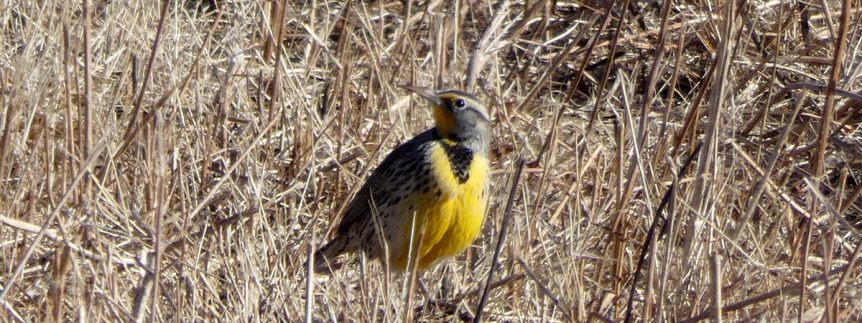Read the Transcript
I’ll bet you’ve heard this happy little fellow many, many times. . .
“The Western Meadowlark, beautiful yellow bird with a black necklace. I always call them ‘little bombers’ because they look like fat little birds out there.”
That’s Tammy VerCauteren, executive director of the Rocky Mountain Bird Observatory.
“They come in and land, and use areas with a little more structure, so the CRP is common, as well as ranch land that maybe haven’t been grazed yet because of the rotational systems on the ranchers’ land.”
Grassland birds are birds of the open grasslands, prairies, and meadows. As a group, these birds have declined in population more than forest or wetland birds.
This month, grassland birds, their habitat needs, and how land enrolled in the Conservation Reserve Program is benefiting these birds.
Studies done for the federal government reveal that as a group, grassland birds have declined in population more than forest or wetland birds. In the next few episodes, we’ll look at the lives of a handful of grassland bird species indigenous to the Great Plains.
If we go to Logan County, on the plains of western Kansas, we can witness a vast amount of pristine rangeland. The Smoky Valley Ranch is owned by The Nature Conservancy, and Matt Bain is the ranch project coordinator.
“We’re about 15 to 20 miles south of Oakley and then six miles north of Scott State Lake. So we’re kind of down in the Smoky Hill River basin.”
It’s about 10 miles by six — nearly 17,000 acres.
“It still is the state’s largest private purchase for conservation.”
This land is very diverse.
“There’s 14 ecosites in Logan County and we have about 12 of those represented on the ranch.”
The ranch is more than just a conservation laboratory.
“We are a working cattle ranch. We take in about 900 pairs of cows every year during the growing season.”
The Smoky Valley Ranch makes diverse bird habitat.
“I know that there is a common theme with grassland nesting birds that really all goes back to maintaining a mosaic of vegetative structure.”
Tammy VerCauteren weaves the bird species around that mosaic.
“Some birds like it really disturbed, so areas where cattle may concentrate. That’s where Mountain Plovers are really going to like to be. But then areas that kind of have some disturbance and then some structure or some height to the vegetation, that’s where your Meadow Larks and your Lark Buntings, your Longspurs like to be. And then on the other end of the spectrum — with more structure, more grasses — that’s going to be Cassin’s Sparrow, and nesting and habitat for Lesser Prairie-Chicken.”
These are birds of the open grasslands, prairies, and meadows. They’re ground foragers of seeds and insects. They’re ground nesters.
Regarding lands enrolled in CRP, in many places, Matt Bain says it represents the only structure adequate for some of these species to nest in.
“If you take CRP out of the landscape, the bird species that have been dependent on them will return to those pre-1985 levels. There’s really no question in my mind that that would happen.”
Smoky Valley Ranch assists bird habitat with moderate cattle grazing practices, and a belief that CRP land matters.
“For The Nature Conservancy, one of our top priorities is to maintain biological diversity. So we look for sensitive species, because those are the first to go. We really feel that it is to everyone’s benefit to keep common species common, and rare species from going extinct.”
Playa Country, which ended in late 2016, was a weekly show that featured conservation and wildlife experts — as well as farmers, ranchers and land managers — talking about conservation practices that improve wildlife habitat and landowners’ bottom-line. Our thanks to Cornell Lab of Ornithology’s Macaulay Library, in Ithaca New York, for the featured bird song.

